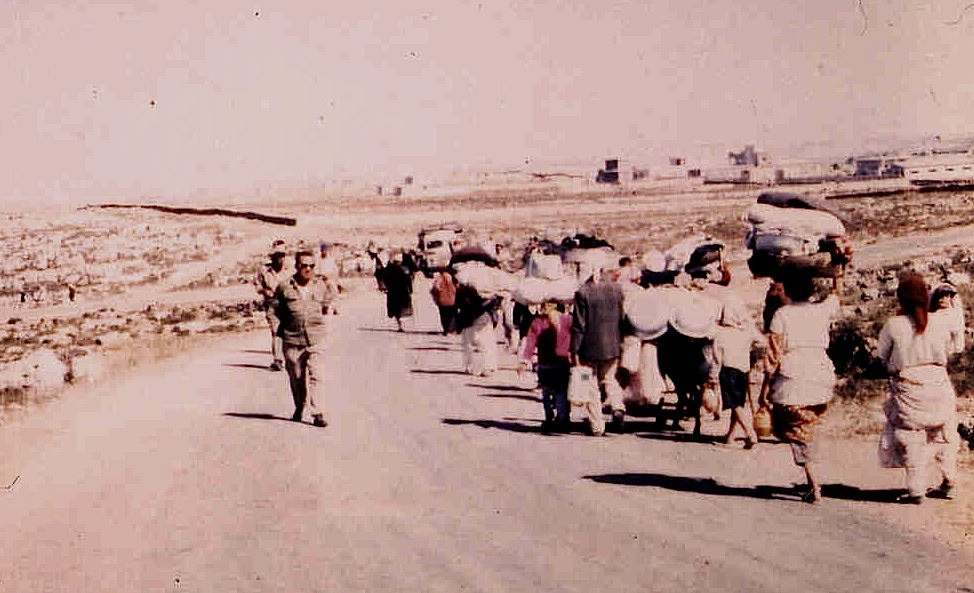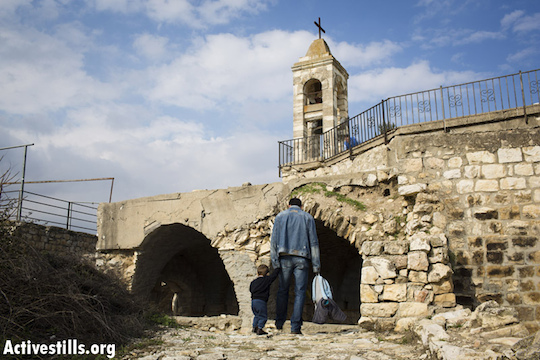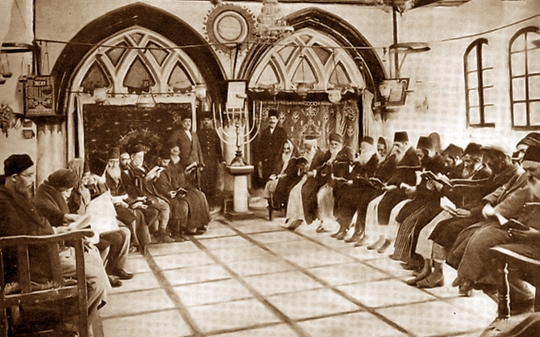Before the advent of Zionism and Arab nationalism, Jews and Palestinians lived in peace in the holy land. Menachem Klein’s new book maps out an oft-forgotten history of Israel/Palestine, and offers some guidance on how we may go back to that time.
By Noam Rotem
Menachem Klein’s book, Lives in Common: Arabs and Jews in Jerusalem, Jaffa and Hebron, is a depressing one. Originally released in English, the book — which is being published in Hebrew — paints a picture of a shared life between Palestinians and Jews at the end of the 19th and the beginning of the 20th centuries, bringing us face to face with daily life, commerce, education, celebrations, and sadness. It shows that us this kind existence, despite everything we were taught by the Israeli education system, is possible. And then Klein goes on and destroys this delicate balance, burning everything left of it today.
As the Ottoman Empire, which ruled Palestine at the time, began losing its power toward the end of the 19th century, a new, local identity began developing out of the lived experiences of Jews and Arabs. This identity, which took precedence over religion, was shared by Muslims, Jews, and Christians.
Following the collapse of the Ottoman Empire during the First World War, both the Zionist movement and the Palestinian national movement began trying to take control of that identity and define the people of the land as either Jewish Zionists or Palestinian Arabs. There were those who called for unity, such as Jerusalem Mayor Raghib al-Nashashibi, who wanted not to speak of Arabs and Jews, but of Palestinians. Klein debunks the myth according to which the residents of the country before the advent Zionism or the Arab national movement lacked all identity. Instead, he describes a lively and vivacious community with its own traditions and customs, bringing testimonies from Jews, Muslims and foreigners as proof.
Both Zionism and Arab nationalism came to Palestine from outside the country. The two movements developed in the diaspora but both saw the territory between the river and the sea as part of their war for control; they drew borders in a place that had been borderless at the expense of those who lived here. Palestinian residents distinguished between “Arab Jews” — a common identity of Jews who were either born here or in other Arab countries — and Jewish immigrants from Europe who arrived to redefine the land. Klein quotes several journal entries penned by Palestinians at the beginning of the 20th century, according to which non-Ashkenazi Jews were seen as awlad al-balad (“sons of the land”) and yahud awlad al-arab (“Jewish Arabs”).
‘The Bolsheviks from Moscow’
The idealistic reality described by Klein seems almost like a dream today. He quotes the memoirs of Ya’akov Elazar from Jerusalem, who remembers how “the Muslim women cooperated respectfully with the customs of the Jewish religion…the Muslim neighbors allowed the Jewish women to pump water necessary before the Sabbath.” Klein also describes how some Muslims even joined their Jewish neighbors in reciting religious prayers. He describes the cheder (a traditional elementary school where the basics of Judaism and the Hebrew language were taught) run by Hacham Gershon in the neighborhood of Sheikh Jarrah, where Arab parents brought their children so that they would learn how to behave properly. Klein also writes that sexual relations and marriages between Jews and Arabs were not unheard of, even if they were not considered legitimate.
The European foreigners who came here were the ones to form a wedged between the partners to this quasi-utopia. Yeshayahu Peres, who put together the historical-geographical encyclopedia of the Land of Israel, complained that when the Ashkenazi Jews immigrated they brought with them their customs, clothing, and lifestyle, and did not adapt to the cultures of Palestine: “They speak Yiddish and maintain the Jewish street accent of their home countries. They are different from their Sephardic brothers not only in language and appearance but also in their worldview.” Or take Palestinian activist Ghada Karmi, who says: “We knew they were different from ‘our Jews,’ I am talking about the Arab Jews. We saw them as foreigners who came from Europe more than as Jews.”
Klein writes that the Zionist establishment invented and nurtured the idealistic image of the Jews as Hebrew-speaking tzabars — as opposed to the Arab Jew. The myth of the tzabar was formed by a culture of immigrants who wanted to see themselves as natives. Maps were redrawn and Arab names of places were ignored or changed to Hebrew names. This was done not only to transform the immigrants into natives, but also to inherit the place of those who were here before. When Yosef Shlush, one of the founders of Tel Aviv, complained that he was attacked by Arabs, the heads of Jaffa’s Arab clans responded: “Who is at fault for all these incidents if not the Bolsheviks you brought from Moscow?”
The first part of the book, which describes life before the Nakba and the 1967 War, is full of historical anecdotes on how Zionism was viewed by the Palestinian leadership. Salim al-Husseini, the mayor of Jerusalem at the end of the 19th century, is quoted: “This is not a political movement as much as it is a settler movement, and I am sure that not a single intelligent, wise Zionist does not imagine the idea of establishing a Jewish state in Palestine.” Najib Azuri, a Maronite Christian from Lebanon who served in the Ottoman administration in Jerusalem and was one of the harbingers of Arab nationalism, said this in 1905: “Both these movements will be resigned to continually struggle until one wins out, the fate of the entire world rests on the results of this struggle between two nations who represent two opposing principles.”
Jamil al-Husseini said in 1914 that Zionism must be fought since its success may bring about the dispossession of Palestinians from their land, while Musa Kazim Pasha al-Husayni, who briefly served as Jerusalem’s mayor and became a famous Palestinian leader, said that, “the Arabs or their leaders do not hate the Jews as Jews. On the contrary, they want Jews present in the framework of an Arab federation… but the Arabs do not agree in any way that a minority of residents say that… they are the lords of the land… we believe that the Jews need to enjoy the rights they deserve relative to their numbers.”
It is not that the first part of the book is bereft of violence, riots, murder, and clashes between groups — but there is some kind of balance. One group kills, the other responds, then they reconcile and go back to living together. Until the next time.
Beyond history

The second half of the book describes what happened after the Nakba, and it is far more pessimistic. Klein claims that 1948 and 1967 were not two separate wars, but rather two rounds of the same war, basing his theory on a convincing comparison and many testimonies from both Jews and Palestinians. He writes about the expulsion of Palestinian from their homes, which were then re-populated by Jews — both in ’48 and ’67.
He describes the stories of refugees who returned to visit their homes and properties that were taken in 1947, and the meetings with the new residents who weren’t always happy to see the refugees. Supreme Court Justice Zvi Berenson, who lived in a Palestinian home, refused to show the house to its former owners, claiming that he had invested much money in renovations. A different refugee who arrived at her old home ran into a Jewish immigrant from Poland who argued that the Poles took her old home, in an attempt to justify the fact that she has done the same thing to the Palestinian standing before her.
Even the personal relationships between Jews and Muslims were disrupted by the wars, such as the one between Ishak Musa al-Husseini and his childhood friend Yaacov Yehoshua. Both studied together and remained friends until they were separated by the 1948 war. After ’67, Yehoshua became a top Israeli clerk, while al-Husseini, whose family lived in the West Bank, came to his Jewish friend to ask for help in retrieving his family’s property. Yehoshua decided not to help him, writing in is journal: “It turns out that you have yet to come to terms with the new Jew — the same one you scorned in the past has now become a brave soldier, a tank crewman, a pilot.”

Klein moves along the years, looking at various failed co-existence initiatives, at the activities of settler organization Elad, until the kidnapping of three Israeli teenagers in 2014 and consequences it had on the residents of the West Bank.
This is where Klein goes from being a historian to being a journalist. “History” is traditionally thought of as something that happened over 30 years ago. Klein takes a dangerous step and tries to connect history to current events. I am of the opinion that the two ought to be separated, while the thorough understanding of the beginning of the last century is replaced by a clouded look at recent events. This creates a feeling in which the reader becomes immersed in the current worldview of the author.
Lives in Common is not a history book, for better or for worse. It is full of lost anecdotes, moving journal entries and memories by the author himself from his childhood in Jerusalem. Klein, a professor of political science at Bar Ilan University, walks the line between being a historian and a writer with a clear, formulated worldview that he has no intention of hiding. He is able to open a door to a time that was purposefully forgotten by the Israeli education system, and show a different reality that existed before the rise of Zionism and Palestinian nationalism.
Despite the wars and passage of time, Klein is able to show that, just maybe, there is hope for a shared life in this land — after all, that reality already existed. He proposes that the two nations, which have been fighting over the same piece of land for the past 100 years, may just be able to go back to living together.
Noam Rotem is an Israeli activist, high-tech executive and author of the blog o139.org, subtitled “Godwin doesn’t live here any more.” This article was first published in Hebrew on Local Call, where he is also a blogger.



